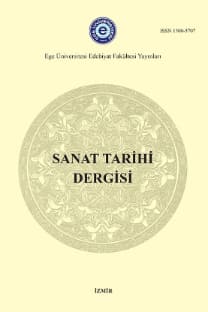Kosova’da Bir Köy Camisi: Rugova Hasan Ağa Camisi
Kosova, Yakova, Balkanlar, Osmanlı mimarisi, Rugova, Sadrazam Yemişçi Hasan Paşa, Kosovo, Gjakova, Balkans, Ottoman architecture, Grand Vizier Yemişçi Hasan Paşa
A Village Mosque in Kosovo: Rogovo Hasan Aga Mosque
Rugova, Kosovo, Gjakova, Balkans, Ottoman architecture, Grand Vizier Yemişçi Hasan Paşa,
___
- Aktepe M., (1997), “Kosova” Maddesi, İslam Ansiklopedisi, Cilt 26, S. 216-219., İstanbul: Türkiye Diyanet Vakfı.
- Andrejeviç, A., (1984), İslamska Monumentalna Umetnost Xvi Veka U Yugoslaviji, Kupolne Camije, Beograd: Beogradski İzdavaçko-Grafiçki.
- Arel A., (1973), “Üç Şerefeli Cami Ve Osmanlı Mimarisinde Tipolojik Sınıflandırma Sorunu”, Mimarlık, Sayı:6, S. 17-20.
- Aslanoğlu İ., (1969) “Tire’de Üç Cami.” Vakıflar Dergisi, Sayı 8/1969, S.161-170.
- Ayverdi, E. H., (2000), Avrupa’da Osmanlı Mimari Eserleri, Eserleri I Romanya Macaristan (1 Ve 2. Kitap), İstanbul: İstanbul Fetih Cemiyeti (İkinci Baskı).
- Bajgora, S. (2013). Destruction Of Islamic Heritage İn The Kosovo War, 1998-1999. Priştine: Interfaith Kosovo, Ministry Of Foreign Affairs Of The Republic Of Kosovo.
- Erarslan, A., (2018), “Mimar Sinan’ın Altıgen Baldaken Sistemli Camilerinde Taşıyıcı, Örtü Ve Mekân İlişkisi”, Osmanlı Mirası Araştırmaları Dergisi (Omad), Cilt 5, Sayı 13, S. 31-48.
- İbrahimgil M. Z. Ve Konuk N., (2006), Kosova’da Osmanlı Mimari Eserleri, Cilt 1, Ankara: Atatürk Kültür, Dil Ve Tarih Yüksek Kurumu, Türk Tarih Kurumu Yayını.
- Kiel, M. (1971). “Observations On The History Of Northern Greece During The Turkish Rule: Historical And Architectural Description Of The Turkish Monuments Of Komotini And Serres, Their Place İn The Development Of Ottoman Turkish Architecture, And Their Present Condition.” Balkan Studies, 12(2), 415-462. Yayınlanma: 2015-07-17.
- Kiel, M., (2002), “Traces İn Stone, Some Notes On A 16Th Century Ottoman Poet From The Balkans, Vâlihî-İ Üskübî And The Background Of His Life And Work”, Journal Of Turkish Studies, Vol.26 / Iı, S.31-41.
- Kiel, M., Hafız, N., (1980), “The Mosque Of Kel Hasan Aga İn The Village Of Rogova”, Prilozi Za Orijentalnu Filologiju, 28-29/411-422, Bosnia And Herzegovina; Orijentalni Institut U Sarajevu.
- Kosova Kitabeleri (2014), İstanbul: İstanbul Fetih Cemiyeti.
- Köprülü O. F., (1997), “Hasan Paşa, Yemişçi (Ö. 1012 / 1603) Osmanlı Sadrazamı” Maddesi, İslam Ansiklopedisi, Cilt 16, S. 342, 343., İstanbul: Türkiye Diyanet Vakfı.
- Krasniqi, N., (2006), “Rolı I Fısnıkërısë Shqıptare Në Zhvıllımın E Kulturës Dhe Cıvılızımıt Islam Në Trojet Shqıptare Gjatë Perıudhës Osmane”, Edukata Islame Revistë Shkencore, Kulturore İslame Tremujore, Viti Xxxv, Nr. 79, S. 95-120., Prishtinë: Kryesia E Bashkësisë Islame E Kosovës.
- Kuban, D., (2007), Osmanlı Mimarisi, İstanbul: Yem Yayın:134. Yapı Endüstri Merkezi.
- Kuban, D., (2009), “Osmanlı Mimarlığı”, Osmanlı Uygarlığı Cilt 2, Editörler: Halil İnalcık-Günsel Renda, Ankara: Kültür Bakanlığı Yayınları (3. Baskı), S. 627-697.
- Nureski, N., (2014) “Osmanlı Kaynaklarına Göre Kültür Merkezi Konumundaki Makedonya Şehirleri Ve Özellikleri”, Balkan Araştırma Enstitüsü Dergisi, Cilt 3, Sayı 1/2014, S. 63-102. Trakya: Trakya Üniversitesi.
- Parlak C., (2015), “Gümülcine’de Kurulmuş Olan Defterdar Ahmed Efendi Vakfı (Xvıı-Xvııı. Yüzyıllar)”, Trakya Üniversitesi Edebiyat Fakültesi Dergisi, Cilt:5, Sayı: 10, S. 199-235.
- Shala S., (2006), “Zbulım I Rëndësıshëm Hıstorık Në Rogovë Të Hasıt”, Edukata Islame, Viti Xxxv, Nr., 80, S.125-153., Piriştine: Kryesia E Bashkësisë Islame E Kosovës.
- Shala S., (2015), Rogova E Hasıt Nëpër Shekuj (Fakte Dhe Dëshmi), Prizren: Shtëpia Botuese Pjetër Bogdanı.
- Sözen, M. (Ed)., (1975), Türk Mimarisinin Gelişimi Ve Mimar Sinan, Türkiye İş Bankası.
- Taç, H., (2012) Hurufât Defterlerine Göre Kosova Vilayeti (Xvııı. Yüzyılın İkinci Yarısı), İzmir: (Ege Üniversitesi, Sosyal Bilimler Enstitüsü, Tarih (Yeniçağ Tarihi) Anabilim Dalı, Yüksek Lisans Tezi.
- Tuluk, Ö. İ., (2006), Osmanlı Camilerinde Mekân Kurgusu Açısından Kare Tabanlı Baldaken Varyasyonları (15.-17.Yy.)”, Gazi Üniversitesi Mühendislik Mimarlık Fakültesi Dergisi, Sayı 21/2, S. 275-285.
- Vırmiça, R., (2012), Kosova’da Osmanlı Mimari Eserleri, Cilt 3, Prizren: Kosova Türk Araştırmacılar Derneği.
- Yılmaz K. H., (2014) “Vâlihî, Kadı-zâde Ahmed Vâlihî Çelebi” maddesi, Türk Edebiyatı İsimler Sözlüğü, Ahmed Yesevi Üniversitesi internet yayını. (yayın tarihi 23. 02. 2014 son güncellenme tarihi 10.12. 2020) http://teis.yesevi.edu.tr/madde-detay/valihi-kadizade-ahmed-valihi-celebi erişim tarihi: 10.04.2022.
- https://dituriaislame.com/edukata-islame/page/5/
- https://journals.openedition.org/etudesbalkaniques/123#tocto3n11
- https://www.ceeol.com/search/article-detail?id=46278
- ISSN: 1300-5707
- Yayın Aralığı: 2
- Başlangıç: 1982
- Yayıncı: Ege Üniversitesi, Edebiyat Fakültesi
19. Yüzyıl İstanbul Minarelerinin Konum, Form, Malzeme ve Süsleme Özellikleri
Zeynep ÖZKAN TEKNECİ, Bozkurt ERSOY
Bizans’ta Aşkın Gözü Kördür! Ortaçağ Boyunca Bizans Sanatında Kör Cupid Figürü
Günümüzde Mobilya Zanaatına Bir Bakış; “Gönen Mobilya" Örneği
Kosova’da Bir Köy Camisi: Rugova Hasan Ağa Camisi
Arnold Hauser, “Sanatın Toplumsal Tarihi” ve Eserin Türkçeye Çevirisi
Çizgi Roman Biçiminde Mimari Temsiller: Archigram
Tuğçe DEMİRHAN KİRİŞ, Nuray ÖZASLAN
Ülkü Dergisi Kapak Tasarımları: Cumhuriyet İdeolojisinin Görsel Temsili
Suna AYDIN ALTAY, Esra ÖZKAN KOÇ
Babadan Oğula Bir Armağan: Girona Sandığı
Atatürk Müze Evleri Bağlamında Raco Atatürk Evinin İncelenmesi
